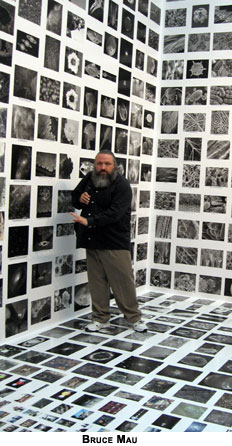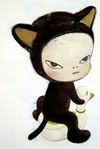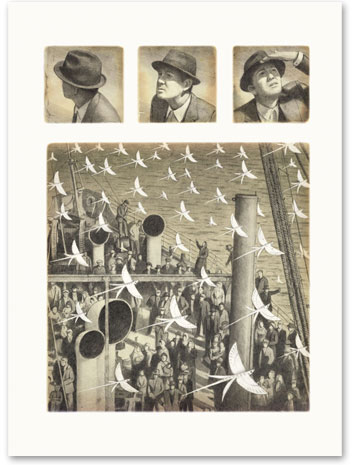
"I realise that I have a recurring interest in notions of ‘belonging’, particularly the finding or losing of it. Whether this has anything to do with my own life, I’m not sure, it seems to be more of a subconscious than conscious concern."
Beyond any personal issues, though, I think that the ‘problem’ of belonging is perhaps more of a basic existential question that everybody deals with from time to time, if not on a regular basis. It especially rises to the surface when things ‘go wrong’ with our usual lives, when something challenges our comfortable reality or defies our expectations – which is typically the moment when a good story begins, so good fuel for fiction. We often find ourselves in new realities – a new school, job, relationship or country, any of which demand some reinvention of ‘belonging’.
This was uppermost in my mind during the long period of work on The Arrival, a book which deals with the theme of migrant experience. Given my preoccupation with ‘strangers in strange lands’, this was an obvious subject to tackle, a story about somebody leaving their home to find a new life in an unseen country, where even the most basic details of ordinary life are strange, confronting or confusing – not to mention beyond the grasp of language. It’s a scenario I had been thinking about for a number of years before it crystallised into some kind of narrative form."
Link: The Arrival by Shaun Tan
23.8.07
a beautiful thing
at 8:18 AM
22.8.07
the visitors from europe
as you all know my faithful readers, I dutifully buy a blueberry bagel with cream cheese from the corner bakery at market and seventh. this bakery is a weird hodgepodge of homeless people from the tail-end of the tenderloin, the suits at the now recently built deathstar/federal building, and travelling tourists from el-cheapo hotel row on seventh street.
this month especially i have seen a barrage of family tourists from europe. you can tell from the way they carry themselves that they are certainly not american, and certainly not of the market street ilk. the typical set includes, a tall dad in capri pants (?!), a mom, and two teenage children.
as i rush to my daily work, i sometimes idealize what these people's lives are like. i wonder where in germany are they from. i sometimes feel bad that their view of san francisco will be blemished by the first blush of the tenderloin "city scent". i also wonder, why on earth are these middle aged men still wearing capris! i gotta give it to the europeans though, their travelling dads look better than american travelling dads with the signature hawaiian shirt and waist high khaki shorts.
back to the work day.
at 9:48 AM
20.8.07
quote of the day
“The pretty, initial position which falls short of completeness is not to be valued - except as a stimulus for further moves.”
--Richard Diebenkorn
at 12:06 PM
16.8.07
point of view
i hate taking a point of view. it takes so much work to take a stake in the ground and say "this is what I am doing for the next year". how does one focus ones adult life in the best way possible.
i've been trying to find a balance in the continuum of being too creative and the other side of being too rigid. the problem with most things is that most people want a clear hook to wrap their brain around you. quite frankly, there is no clear hook around me.
i am a creative person who wants to spread my ideas to the world. the problem with this definition is that often the path from idea to spread ideas to the world, is long and fraught with obstacles, and often involved coordination with many people. i've been mulling over the idea of switching over to corporate land where things are much more stable and regimented in terms of process.
the biggest take away from my implementation class, is that life is about finding the right scope of challenges to take on. now that i have graduated, the world has opened up at an overwhelming speed, but i continue to feel like the opportunities around me are few and far in between. how could one simultaneously have these two feelings? but i do.
my friend chris took his dog who lives in central valley with a nice yard to his small san francisco apartment. i forgot her name, but lets call her dolly. dolly was frightened to death of the new environment so she stayed in chris's room, tail between her legs. chris discovered a neat way to open her up, she put a leash on her neck and soon dolly opened up and walked around the house, bright eyed and willing to explore. after an hour or so chris took the leash out and she was happy to run about the house.
was college supposed to be the leash? i think i need a little more leash time.
one nonsequitur. i have decided to not capitalize any of my sentences for this blog and i must say it has increased my productivity by probably 5%.
Steve Jobs is so awesome. Its really disappointing that he's sort of an asshole as a person. But its ok, he's still pretty damn awesome. I really liked this interview that he did with wired magazine.
15.8.07
Some Cool Things
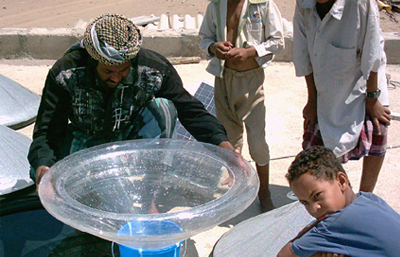
The Watercone® is a solar powered water desalinator that takes salt or brackish water and generates freshwater. It is simple to use, lightweight and mobile. The technology is simple in design and use and is discribed by simple pictograms. With max. 1,6 liters a day the Watercone® is an ideal device to cover a childs daily need of freshwater. UNICEF: "every day 5000 children die as a result of diarrhea coused by drinking unsafe water"
Link:Watercone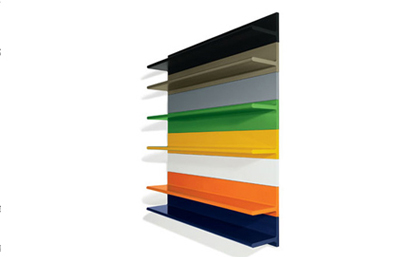
A pretty thing. Some sort of shelving system.
Link:Basaglia and Nodari System
A very cool infographic music video.
This is not bad either
at 10:05 AM
Labels: design, product design
14.8.07
Bruce Mau's Incomplete Manifesto For Growth and other uplifting things
Today I ran into icon magazine's "manifesto" issue. It lists 50 designers and their beliefs on the current state of the design world. I very much enjoy reading these words to inspire and drive me to work harder as a young designer. The first manifesto is from a designer named Peter Saville which very clearly articulates what I feel is wrong with the current state of design -- that is that it is intrinsically tied to having to make a profit.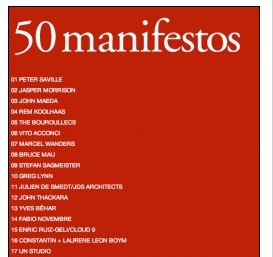
Morals
The cultural adventure has been consumed by business. Making things better is a moral issue, but morality and business don’t go together – business is, if not immoral, then amoral. We know we should be keeping people out of stores but we all have to work with business. It can’t really be all about idealism and altruism.
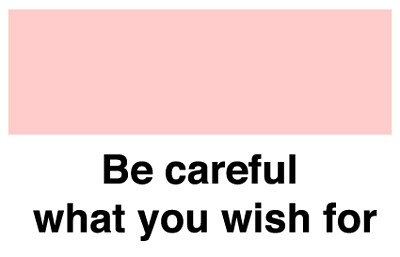
However, I recently finished reading "Confessions of a Serial Entrepreneur" and found some pretty straightforward advice from an entrepreneur named Stuart Skorman. Earlier this year I was working on a project to help mom and pop video stores using design strategy and research and one of our interviews lead us a store owner who had been approached by Mr. Skorman. Skorman created some minorly successful dot.coms and more notably elephant pharmacy and seemed to have some pretty down to earth, straight talking approach to what good design and business. I will elaborate more later.
Here is another case where we are faced with multiple frames to look at this problem. For instance, there is the more local frame of having to make a living, the higher frame of creating meaningful stuff, and of course, every designers dream to create beautiful, functional things that affect people's lives in a positive way. Its a lofty goal and I am always inspired when I see things on Notcot that seem like great ideas.
Bruce Mau was another one of the people who had a great manifesto. I remember stumbling onto his "Incomplete Manifesto for Growth" when I was a senior in high school and being tremendously inspired by it-- it is what ultimately made me want to become a designer instead of a painter.
An Incomplete Manifesto for Growth
Written in 1998, the Incomplete Manifesto is an articulation of statements that exemplify Bruce Mau's beliefs, motivations and strategies. It also articulates how the BMD studio works.
1. Allow events to change you. You have to be willing to grow. Growth is different from something that happens to you. You produce it. You live it. The prerequisites for growth: the openness to experience events and the willingness to be changed by them.
2. Forget about good. Good is a known quantity. Good is what we all agree on. Growth is not necessarily good. Growth is an exploration of unlit recesses that may or may not yield to our research. As long as you stick to good you'll never have real growth.
3. Process is more important than outcome. When the outcome drives the process we will only ever go to where we've already been. If process drives outcome we may not know where we’re going, but we will know we want to be there.
4. Love your experiments (as you would an ugly child). Joy is the engine of growth. Exploit the liberty in casting your work as beautiful experiments, iterations, attempts, trials, and errors. Take the long view and allow yourself the fun of failure every day.
5. Go deep. The deeper you go the more likely you will discover something of value.
6. Capture accidents. The wrong answer is the right answer in search of a different question. Collect wrong answers as part of the process. Ask different questions.
7. Study. A studio is a place of study. Use the necessity of production as an excuse to study. Everyone will benefit.
8. Drift. Allow yourself to wander aimlessly. Explore adjacencies. Lack judgment. Postpone criticism.
9. Begin anywhere. John Cage tells us that not knowing where to begin is a common form of paralysis. His advice: begin anywhere.
10. Everyone is a leader. Growth happens. Whenever it does, allow it to emerge. Learn to follow when it makes sense. Let anyone lead.
11. Harvest ideas. Edit applications. Ideas need a dynamic, fluid, generous environment to sustain life. Applications, on the other hand, benefit from critical rigor. Produce a high ratio of ideas to applications.
12. Keep moving. The market and its operations have a tendency to reinforce success. Resist it. Allow failure and migration to be part of your practice.
13. Slow down. Desynchronize from standard time frames and surprising opportunities may present themselves.
14. Don’t be cool. Cool is conservative fear dressed in black. Free yourself from limits of this sort.
15. Ask stupid questions. Growth is fueled by desire and innocence. Assess the answer, not the question. Imagine learning throughout your life at the rate of an infant.
16. Collaborate. The space between people working together is filled with conflict, friction, strife, exhilaration, delight, and vast creative potential.
17. ____________________. Intentionally left blank. Allow space for the ideas you haven’t had yet, and for the ideas of others.
18. Stay up late. Strange things happen when you’ve gone too far, been up too long, worked too hard, and you're separated from the rest of the world.
19. Work the metaphor. Every object has the capacity to stand for something other than what is apparent. Work on what it stands for.
20. Be careful to take risks. Time is genetic. Today is the child of yesterday and the parent of tomorrow. The work you produce today will create your future.
21. Repeat yourself. If you like it, do it again. If you don’t like it, do it again.
22. Make your own tools. Hybridize your tools in order to build unique things. Even simple tools that are your own can yield entirely new avenues of exploration. Remember, tools amplify our capacities, so even a small tool can make a big difference.
23. Stand on someone’s shoulders. You can travel farther carried on the accomplishments of those who came before you. And the view is so much better.
24. Avoid software. The problem with software is that everyone has it.
25. Don’t clean your desk. You might find something in the morning that you can’t see tonight.
26. Don’t enter awards competitions. Just don’t. It’s not good for you.
27. Read only left-hand pages. Marshall McLuhan did this. By decreasing the amount of information, we leave room for what he called our "noodle."
28. Make new words. Expand the lexicon. The new conditions demand a new way of thinking. The thinking demands new forms of expression. The expression generates new conditions.
29. Think with your mind. Forget technology. Creativity is not device-dependent.
30. Organization = Liberty. Real innovation in design, or any other field, happens in context. That context is usually some form of cooperatively managed enterprise. Frank Gehry, for instance, is only able to realize Bilbao because his studio can deliver it on budget. The myth of a split between "creatives" and "suits" is what Leonard Cohen calls a 'charming artifact of the past.'
31. Don’t borrow money. Once again, Frank Gehry’s advice. By maintaining financial control, we maintain creative control. It’s not exactly rocket science, but it’s surprising how hard it is to maintain this discipline, and how many have failed.
32. Listen carefully. Every collaborator who enters our orbit brings with him or her a world more strange and complex than any we could ever hope to imagine. By listening to the details and the subtlety of their needs, desires, or ambitions, we fold their world onto our own. Neither party will ever be the same.
33. Take field trips. The bandwidth of the world is greater than that of your TV set, or the Internet, or even a totally immersive, interactive, dynamically rendered, object-oriented, real-time, computer graphic–simulated environment.
34. Make mistakes faster. This isn’t my idea -- I borrowed it. I think it belongs to Andy Grove.
35. Imitate. Don’t be shy about it. Try to get as close as you can. You'll never get all the way, and the separation might be truly remarkable. We have only to look to Richard Hamilton and his version of Marcel Duchamp’s large glass to see how rich, discredited, and underused imitation is as a technique.
36. Scat. When you forget the words, do what Ella did: make up something else ... but not words.
37. Break it, stretch it, bend it, crush it, crack it, fold it.
38. Explore the other edge. Great liberty exists when we avoid trying to run with the technological pack. We can’t find the leading edge because it’s trampled underfoot. Try using old-tech equipment made obsolete by an economic cycle but still rich with potential.
39. Coffee breaks, cab rides, green rooms. Real growth often happens outside of where we intend it to, in the interstitial spaces -- what Dr. Seuss calls "the waiting place." Hans Ulrich Obrist once organized a science and art conference with all of the infrastructure of a conference -- the parties, chats, lunches, airport arrivals — but with no actual conference. Apparently it was hugely successful and spawned many ongoing collaborations.
40. Avoid fields. Jump fences. Disciplinary boundaries and regulatory regimes are attempts to control the wilding of creative life. They are often understandable efforts to order what are manifold, complex, evolutionary processes. Our job is to jump the fences and cross the fields.
41. Laugh. People visiting the studio often comment on how much we laugh. Since I've become aware of this, I use it as a barometer of how comfortably we are expressing ourselves.
42. Remember. Growth is only possible as a product of history. Without memory, innovation is merely novelty. History gives growth a direction. But a memory is never perfect. Every memory is a degraded or composite image of a previous moment or event. That’s what makes us aware of its quality as a past and not a present. It means that every memory is new, a partial construct different from its source, and, as such, a potential for growth itself.
43. Power to the people. Play can only happen when people feel they have control over their lives. We can't be free agents if we’re not free.

Onto more inspiring things, there are always the TED talks. I especially like Dr. Roslings engaging information graphics on the state of the world through lenses of quality of life (such as healthcare, etc, etc).
LINKS:
icon magazine's "manifesto issue": fifty manifestos of today's leading design figures who actually care about the state of the world.
Confessions of a Serial Entrepreneur: a great book for any aspiring entrepreneur.
Bruce Mau's Incomplete Manifesto for growth: The entire text is in this blog entry. This manifesto has inspired me in so many ways and affected the way I think to this day.
Ted Talks: Ideas of amazing, inspiring and intellegent people who are trying to change the world.
Damn why do I have to be such an idealist.
6.8.07
Weekend Festivities
Were there really wasn't that much...
I did finally finish the last Harry Potter book. I enjoyed most of it, a bit slow-going at the beginning, but the wizard duels etc, etc, seemed appropriate for the finale of a seven book series.
I managed to get my hands on a Swiss version of Harry Potter and the Sorcerer's Stone. Having just seen the fifth movie two weeks ago and just finished the final book, I thought it would be fun to contrast how much the actors have grown and also to see if there were anything that would make sense now that I know the entire story that would've been imperceptible back then. The only thing I noted was the use of Dumbledore's deluminator and of coures, Ron receives it in the final book. However, I just started re-reading the first book also and it was certainly called a different name then. 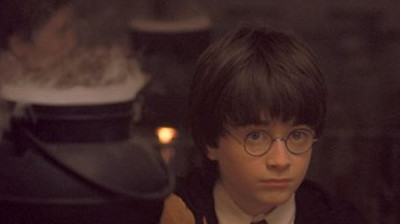
I very much enjoyed the movie.
I also randomly ran across the great website of a webdesigner/graphic designer/coder named Jonathan Harris. Looking at his work, I noticed that he has responsible for many of the things that I find wonderful in interaction design including:
1)10X10 a news aggregator 2) the graphic layout/interface of etsy.com 3)some mints I noticed at the airport called oral fixation
and finally I really enjoyed wefeelfine.org which scours the blogosphere for the phrase "i feel" and creates graphical representations to analyze the data and to look at what people across the world are feeling right now.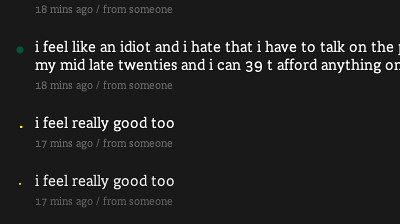
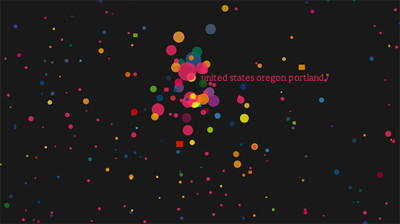
3.8.07
friday
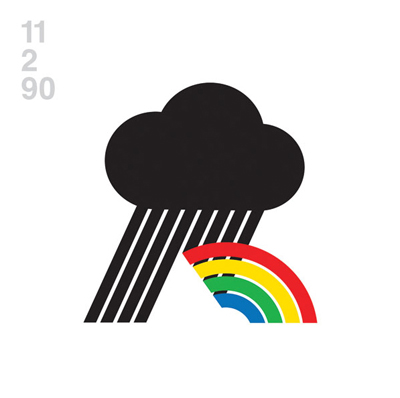
I discovered that a lot of people are creating PDF magazines. Its a great way to get graphic design inspiration. I loved the Candy Collective mag's feature on the use of Helvetica font through the years.
This site has a great listing and links. I also really love Adobe's PDF magazine for design professionals.
"You know I dreamed about you
for twenty-nine years before I saw you
You know I dreamed about you
I missed you for
for twenty-nine years"
2.8.07
a more design centered blog
I really ought to have a stronger point of view for this blog.
The last few months have taught me much about the strength of messaging and the importance of a strong point of view.
I thought I would just list some sites that I visit everyday:
Notcot.org
is a very visually stunning and daily updated design journal. I like it because it doesn't have words and I usually just get eyecandy
Popurls
is an aggregator of aggregators. I tried fiddling with Netvibes or with igoogle, but popurls is punchy. Besides I usually only read the Reddit entries , and if I feel like catching up on more webdev stuff, probably delicious.com
Gmail
I love Gmail. It is the best web client out there, and it is awesome, I dont need anythign else
1.8.07
website creation
I dont usually talk about work related things, but I thought I would like to document my webcreation process. Throughout college, I've always been amazed by well-designed websites. It didn't seem that complicated to me, as almost invariably most of these websites were created by "graphic designers", thus, must not be that complicated.
I decided to take on the challenge of re-designinging my company website. First I had to learn CSS as i had learned from a product designer/ web developer friend that it is the new standard for web design. So I looked it up. I'm not sure what entirely the benefit of it is, other than the actual process of learning CSS "containers", floating and creating layout in general, has afforded a new way of design. It is indeed much more flexible to redesign the individual elements of a website and really, the table based design of HTML days of yore really is quite cumbersome.
So I learned CSS all of last week.
I had a tutorial from my webdev friend a few months ago where he taught me the difference betweens
I then went and tagged websites that were very well done.
Smashing Magazine has some very good resources for web inspiration. I then also looked for company websites in my company's "category" of products and sought for inspiration there. Most designs in that category were simply lackluster, but it is best to keep this in mind, as our clientelle would probably be more intimidated than impressed by a fashion forward website.
I then had to learn the nuts and bolts of CSS. So I delicioused CSS and true enough, it was a gold mine of resources. For any webdevs out there, I hihgly recommend using delicious for all your researching needs. My two favorite websites for this are:
1) HTML Dog and 2) W3 Schools. These two sites will give you everything you need to know to catch up on sites.
Then came the bewildering idea of how to handle tables now that CSS has completely obliterated tables. For some reason, the idea of floating was completely bewildering to me and some websites were simply floating left and floating right; this is a completely different way of doing it with tables. Somehow this website explained everything I needed to know .
Then came the problem with Menus. I liked the idea of having drop down menus as they look streamlined and allow for easier navigation. I liked Stu Nicholl's site for its amazingly extensive collection of open source Menus completely done in CSS. However, I wanted to do a combination of text and images rollovers and this site albeit butt ugly looks promising.
Finally, I also had to learn flash because my boss wanted me incorprate it into its website. This site was surprisingly the most straightforward way to learn flash. Then I wanted to get ambitious and add clickable elements to my swf. Amazingly Adobe has a very rich collection of video resources that I highly recommend. Talk about taking advantage of their own platform (so awesome).
I absolutely love the internet. If I run into any problem I simply google it and I can pretty much find a little forum somewhere, or a tutorial site that discusses the very problem I have. How amazing when you create an entirely open platform.
at 5:45 PM
Labels: graphics, research, web design
